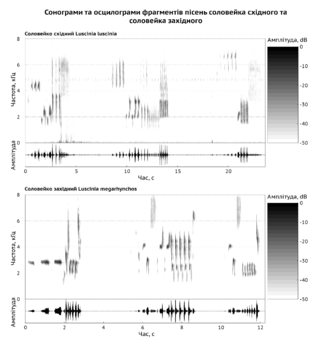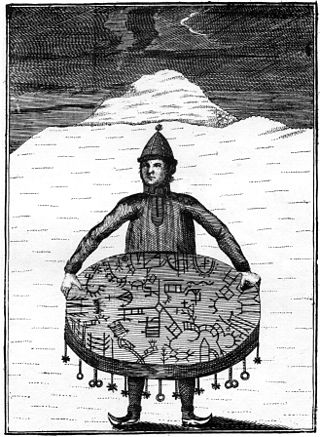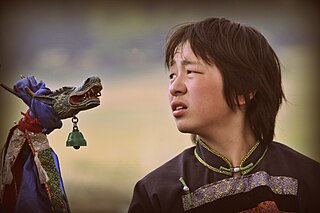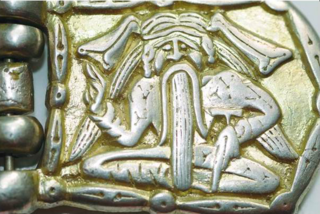Related Research Articles

Shamanism or samanism is a religious practice that involves a practitioner interacting with the spirit world through altered states of consciousness, such as trance. The goal of this is usually to direct spirits or spiritual energies into the physical world for the purpose of healing, divination, or to aid human beings in some other way.

Bioacoustics is a cross-disciplinary science that combines biology and acoustics. Usually it refers to the investigation of sound production, dispersion and reception in animals. This involves neurophysiological and anatomical basis of sound production and detection, and relation of acoustic signals to the medium they disperse through. The findings provide clues about the evolution of acoustic mechanisms, and from that, the evolution of animals that employ them.
A soundscape is the acoustic environment as perceived by humans, in context. The term was originally coined by Michael Southworth, and popularised by R. Murray Schafer. There is a varied history of the use of soundscape depending on discipline, ranging from urban design to wildlife ecology to computer science. An important distinction is to separate soundscape from the broader acoustic environment. The acoustic environment is the combination of all the acoustic resources, natural and artificial, within a given area as modified by the environment. The International Organization for Standardization (ISO) standardized these definitions in 2014.
Zoomusicology is the study of the musical aspects of sound and communication as produced and perceived by animals. It is a field of musicology and zoology, and is a type of zoosemiotics. Zoomusicology as a field dates to François-Bernard Mâche's 1983 book Music, Myth, and Nature, or the Dolphins of Arion, and has been developed more recently by scholars such as Dario Martinelli, David Rothenberg, Hollis Taylor, David Teie, and Emily Doolittle.

A noaidi is a shaman of the Sami people in the Nordic countries, playing a role in Sámi religious practices. Most noaidi practices died out during the 17th century, most likely because they resisted Christianization of the Sámi people and the king's authority. Their actions were referred to in courts as "magic" or "sorcery". Several Sámi shamanistic beliefs and practices are similar to those of some Siberian cultures.
Prehistoric music is a term in the history of music for all music produced in preliterate cultures (prehistory), beginning somewhere in very late geological history. Prehistoric music is followed by ancient music in different parts of the world, but still exists in isolated areas. However, it is more common to refer to the "prehistoric" music which still survives as folk, indigenous or traditional music. Prehistoric music is studied alongside other periods within music archaeology.
Beaver & Krause were an American musical duo comprising Paul Beaver and Bernie Krause. Their 1967 album The Nonesuch Guide to Electronic Music was a pioneering work in the electronic music genre. The pair were Robert Moog's sales representatives on the U.S. West Coast and were instrumental in popularizing the Moog synthesizer during the late 1960s. As recording artists for Warner Bros. Records in the early 1970s, they released the critically admired albums In a Wild Sanctuary and Gandharva.
Acoustic ecology, sometimes called ecoacoustics or soundscape studies, is a discipline studying the relationship, mediated through sound, between human beings and their environment. Acoustic ecology studies started in the late 1960s with R. Murray Schafer a musician, composer and former professor of communication studies at Simon Fraser University with the help of his team there as part of the World Soundscape Project. The original WSP team included Barry Truax and Hildegard Westerkamp, Bruce Davies and Peter Huse, among others. The first study produced by the WSP was titled The Vancouver Soundscape. The interest in this area grew enormously after this pioneer and innovative study and the area of acoustic ecology raised the interest of researchers and artists all over the world. In 1993, the members of the by now large and active international acoustic ecology community formed the World Forum for Acoustic Ecology.

Bernard L. Krause is an American musician and soundscape ecologist. In 1968, he founded Wild Sanctuary, an organization dedicated to the recording and archiving of natural soundscapes. Krause is an author, a bio-acoustician, a speaker, and natural sound artist who coined the terms geophony, biophony, and anthropophony.

A large minority of people in North Asia, particularly in Siberia, follow the religio-cultural practices of shamanism. Some researchers regard Siberia as the heartland of shamanism.

Hungarian mythology includes the myths, legends, folk tales, fairy tales and gods of the Hungarians, also known as the Magyarok.
Soul dualism, also called dualistic pluralism or multiple souls, is a range of beliefs that a person has two or more kinds of souls. In many cases, one of the souls is associated with body functions and the other one can leave the body. Sometimes the plethora of soul types can be even more complex. Sometimes, a shaman's "free soul" may be held to be able to undertake a spirit journey.

Traditional Alaskan Native religion involves mediation between people and spirits, souls, and other immortal beings. Such beliefs and practices were once widespread among Inuit, Yupik, Aleut, and Northwest Coastal Indian cultures, but today are less common. They were already in decline among many groups when the first major ethnological research was done. For example, at the end of the 19th century, Sagdloq, the last medicine man among what were then called in English, "Polar Eskimos", died; he was believed to be able to travel to the sky and under the sea, and was also known for using ventriloquism and sleight-of-hand.

Hungarian shamanism is discovered through comparative methods in ethnology, designed to analyse and search ethnographic data of Hungarian folktales, songs, language, comparative cultures, and historical sources.
Biomusic is a form of experimental music which deals with sounds created or performed by non-humans. The definition is also sometimes extended to include sounds made by humans in a directly biological way. For instance, music that is created by the brain waves of the composer can also be called biomusic as can music created by the human body without the use of tools or instruments that are not part of the body.
The imitation of natural sounds in various cultures is a diverse phenomenon and can fill in various functions. In several instances, it is related to the belief system. It may serve also such practical goals as luring in the hunt; or entertainment.
Shamanism in various cultures shows great diversity. In some cultures, shamanic music may intentionally mimic natural sounds, sometimes with onomatopoeia. Imitation of natural sounds may also serve other functions not necessarily related to shamanism, such as luring in the hunt; and entertainment.

Soundscape ecology is the study of the acoustic relationships between living organisms, human and other, and their environment, whether the organisms are marine or terrestrial. First appearing in the Handbook for Acoustic Ecology edited by Barry Truax, in 1978, the term has occasionally been used, sometimes interchangeably, with the term acoustic ecology. Soundscape ecologists also study the relationships between the three basic sources of sound that comprise the soundscape: those generated by organisms are referred to as the biophony; those from non-biological natural categories are classified as the geophony, and those produced by humans, the anthropophony.
Ecomusicology is an area of study that explores the relationships between music or sound, and the natural environment. It is a study which encompasses a variety of academic disciplines including musicology, biology, ecology and anthropology. Ecomusicology combines these disciplines to explore how sound is produced by natural environments and, more broadly how cultural values and concerns about nature are expressed through sonic mediums. Ecomusicology explores the ways that music is composed to replicate natural imagery, as well as how sounds produced within the natural environment are used within musical composition. Ecological studies of sounds produced by animals within their habitat are also considered to be part of the field of ecomusicology. In the 21st century, studies within the field the ecomusicology have also become increasingly interested in the sustainability of music production and performance.
Shamanism is a religious practice present in various cultures and religions around the world. Shamanism takes on many different forms, which vary greatly by region and culture and are shaped by the distinct histories of its practitioners.
References
- Kaplan, Stephen (1995). "The Restorative Benefits of Nature: Toward and Integrative Framework". Journal of Environmental Psychology. 15 (3): 169–182. doi:10.1016/0272-4944(95)90001-2.
- Alvarisson, Jesper J (2010). "Stress Recovery during Exposure to Nature Sound and Environmental Noise". International Journal of Environmental Research and Public Health. 7 (3): 1036–1046. doi: 10.3390/ijerph7031036 . PMC 2872309 . PMID 20617017.
- Deschênes, Bruno (2002). "Inuit Throat-Singing". Musical Traditions. The Magazine for Traditional Music Throughout the World.
- Diószegi, Vilmos (1960). Sámánok nyomában Szibéria földjén. Egy néprajzi kutatóút története. Terebess Ázsia E-Tár (in Hungarian). Budapest: Magvető Könyvkiadó. The book has been translated to English: Diószegi, Vilmos (1968). Tracing shamans in Siberia. The story of an ethnographical research expedition. Translated from Hungarian by Anita Rajkay Babó. Oosterhout: Anthropological Publications.
- Hoppál, Mihály (2005). Sámánok Eurázsiában (in Hungarian). Budapest: Akadémiai Kiadó. ISBN 963-05-8295-3. The title means “Shamans in Eurasia”, the book is published also in German, Estonian and Finnish. Site of publisher with short description on the book (in Hungarian).
- Hoppál, Mihály (2006). "Music of Shamanic Healing" (PDF). In Gerhard Kilger (ed.). Macht Musik. Musik als Glück und Nutzen für das Leben. Köln: Wienand Verlag. ISBN 3-87909-865-4.[ permanent dead link ]
- Lintrop, Aarno. "The Clean Tent Rite". Studies in Siberian shamanism and religions of the Finno-Ugric peoples.
- Nattiez, Jean Jacques. "Inuit Games and Songs • Chants et Jeux des Inuit". Musiques & musiciens du monde • Musics & musicians of the world. Montreal: Research Group in Musical Semiotics, Faculty of Music, University of Montreal.
{{cite journal}}: Cite journal requires|journal=(help). The songs are online available from the ethnopoetics website curated by Jerome Rothenberg. - Somby, Ánde (1995). "Joik and the theory of knowledge". Archived from the original on 2008-03-25.
- Szomjas-Schiffert, György (1996). Lapp sámánok énekes hagyománya • Singing tradition of Lapp shamans (in Hungarian and English). Budapest: Akadémiai Kiadó. ISBN 963-05-6940-X.
- Krause, Bernie (2012). The Great Animal Orchestra: Finding the Origins of Music in the World's Wild Places . Little Brown/Hachette. ISBN 978-0-316-08687-5.